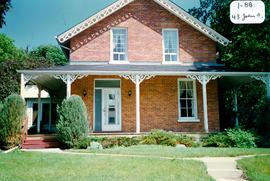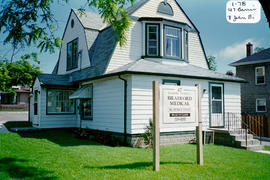43 John Street East - The William Campbell House
- CA BWGPL GJ-HB-2017-04-04-08
- Item
- 1996
Part of George Jackson fonds
The William Campbell House is located mid-block on the north side at 43 John Street East. It was built around 1880 in the Gothic Revival style. This structure was once the home of William H. Campbell Sr. (a grain merchant) and his wife Bessie (Sutherland). His son Lewis was a doctor, and William L. (Billie) was a druggist. His daughter (Elizabeth/Libby) was born close to the day of the great fire of 1871 (Libby was born 15 May 1871 while the fire began on 25 May). She never married, though she took over her father's business after his death and remained in this house until her own. Dr. S. Hecking and his family purchased the house in the 1950’s and had it remodeled. He had one son (Stephen Jr.) and one daughter. As of 1995, Doctor Hecking was retired, training horses, and still riding occasionally.
The 1½-storey, ‘L’-shaped main building has a one-storey, rear addition. It also has a medium-pitched, gable roof with tall chimney stacks. An elaborately-carved bargeboard and brackets support the wrap-around porch. The wide entrance has sidelights and a transom. There are large window openings, high floor to ceiling heights, and large windows (4/4 sash windows at the ground floor). The structure has load-bearing, brick masonry construction and a stone foundation. According to the 2000 inventory, additions, replacement doors and the second-floor windows on the well-maintained house stray from the original design intent. (1, 2, 3, 5)
George Jackson


